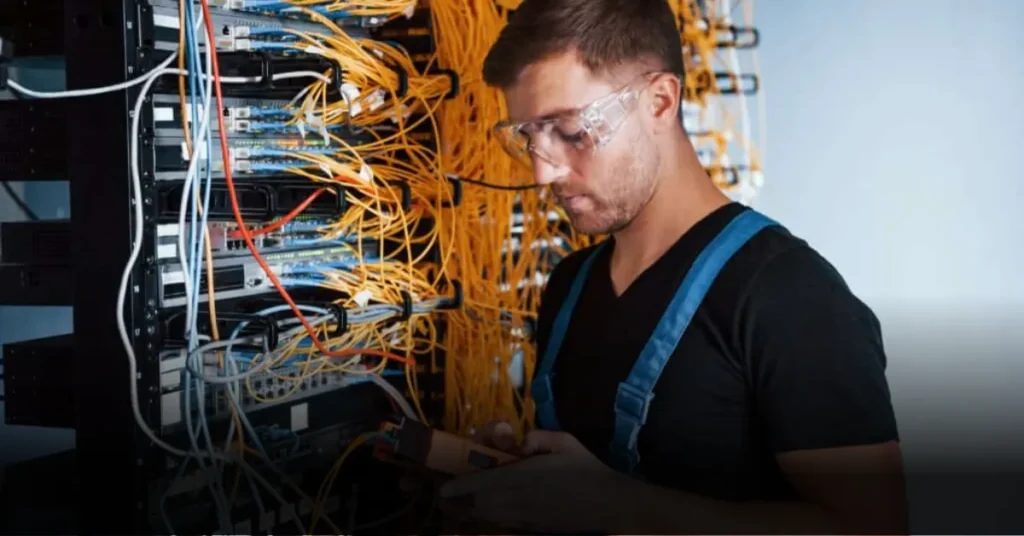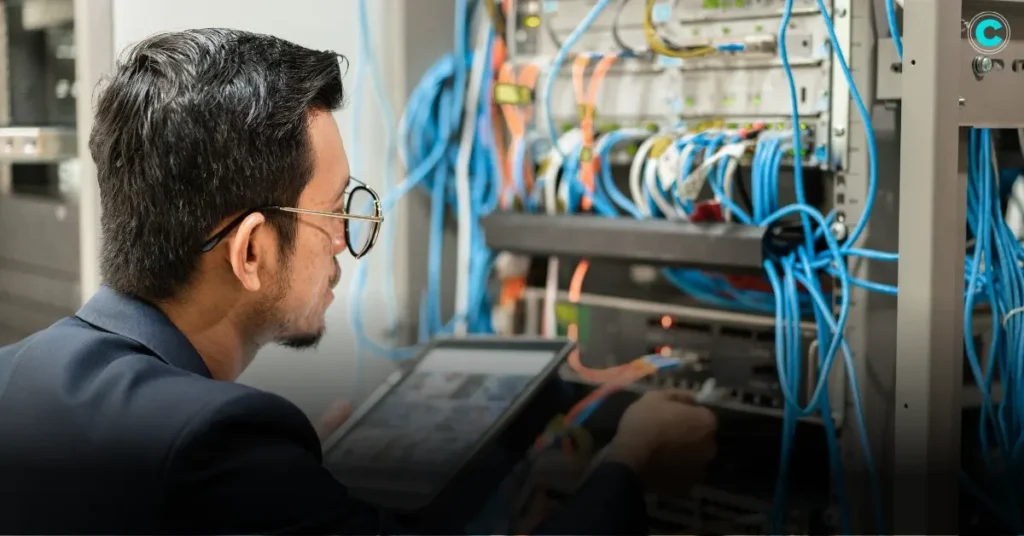200+ Duties of Network Engineer Jobs 2025 Complete Guide
Are you a student or IT worker who wants a strong future job? Do you want to enter a field that is always growing and has high demand? You can think about becoming a Network Engineer.
The world of computer networks is growing very fast. The year 2025 is bringing many new job chances in this field. In this guide, we will explain the job in simple words. You will see the many duties, skills, and tools you need. By the end, you will have a full roadmap for building your career as a Network Engineer.
A Network Engineer today is not just a person who connects routers, switches, and firewalls. The role is now bigger. You must work as an architect, a security guard, and sometimes even a programmer.
The Architects of Connectivity: Redefining the Network Engineer in 2025
The Network Engineer is now the heart of the IT system in every company. They design, build, and take care of the digital networks that connect everything. These networks help remote work, cloud systems, and smart devices (IoT).
The old idea of a “network guy” is gone. Today’s digital world needs experts in automation, cloud, and security.
In Pakistan, the average salary of a Network Engineer is PKR 3,119,623 per year. Senior engineers can even make PKR 3,809,060 per year. This shows that the career has a big future.
Section 1: The Blueprint & The Build
A network is like a building. It needs a strong foundation. A big part of a Network Engineer’s duty is planning and building the system step by step.
Architecting the Digital Backbone: Network Design and Planning
Before you connect a cable, you must plan like an architect. This includes:
Also Read: 150+ Duties of Junior Admin IT Executive Jobs 2025 HR Ways Islamabad Complete Guide
- Meeting with stakeholders: Talking with business and IT people to know their needs. Example: setting up a new office, a data center, or a new app.
- Doing site surveys and planning capacity: Checking the place, seeing space, power, and planning how much internet and devices are needed for now and the future.
- Making network diagrams: Creating simple maps (both logical and physical) to explain how the network will look.
- Building a bill of materials: Writing a clear list of all tools like routers, switches, firewalls, cables, and licenses.
- Checking vendor solutions: Looking at products from Cisco, Juniper, or others, and picking the best new technology.
- Designing scalable topologies: Making the system ready for growth, and adding backup paths for high availability.

From Plan to Reality: Network Implementation and Configuration
After the plan, the next step is action. You set up the network in the real world. Duties include:
- Rack and stack: Installing and arranging network devices neatly in server racks.
- Configuring routers and switches: Setting IP addresses, routing rules, and security policies.
- Setting VLANs and routing: Dividing the network into smaller groups for better speed and safety.
- Applying static and dynamic routing: Making sure devices can send data through the best paths.
- Installing wireless access points: Giving strong Wi-Fi (like Wi-Fi 6) to users.
- Building VPNs: Giving secure remote access to employees working from home.
- Adding DNS and DHCP: Setting up servers that give automatic IPs and help devices find websites.
Section 2: The Digital Watchtower
After building the network, the work is not over. A network is alive and must be watched and tuned all the time.
The Sentinel’s Eye: Proactive Monitoring and Performance Tuning
Good engineers stop problems before they happen. They use tools and smart rules. Tasks include:
- Using network monitoring systems (NMS): Tools that show device health and alerts in real-time.
- Configuring SNMP and Syslog: Making devices send logs and alerts.
- Watching traffic and bandwidth: Finding slow spots and planning for more capacity.
- Applying Quality of Service (QoS): Making sure important traffic like video calls gets priority.
- Reducing latency and improving speed: Keeping critical apps smooth.
- Using AI and machine learning (AIOps): Predicting and stopping problems before they happen.
The Digital Detective: Troubleshooting and Problem Resolution
When problems happen, the Network Engineer becomes a detective. They must find the cause fast. Duties include:
- Checking connectivity with Ping and Traceroute: Seeing if devices can connect and where delays are.
- Using Wireshark for packet capture: Studying data packets to find errors.
- Isolating faults: Testing parts of the network step by step.
- Fixing DNS and DHCP issues: Making sure devices can connect to the internet.
- Doing root cause analysis: Not just fixing but learning why the problem happened, to stop it in the future.
Section 3: The Shield and the Sword
In today’s world, cybercrime is rising. Security is not separate from networking anymore. Every Network Engineer is also a protector.
Fortifying the Castle: Network Security and Access Control
The engineer must guard the network like a castle. Their main tasks are:
- Installing and managing firewalls: Stopping bad traffic.
- Setting IDS/IPS systems: Detecting and blocking attacks.
- Applying Access Control Lists (ACLs): Giving or blocking access based on rules.
- Using Zero Trust security: Always verifying users, never trusting anyone by default.
- Managing user authentication (RADIUS, TACACS+): Making sure only real users get in.
- Running vulnerability scans and penetration tests: Testing the network before hackers can attack.
Network Engineer Jobs 2025 Complete Guide
| Job Type | Network Engineer |
|---|---|
| Application Date | 3 Oct 2025 |
| Job Location | Islamabad |
| Experience Level | Entry to Senior |
| Salary Range | High level |
| Official Website | Apply Online Through |
Section 4: The Cloud, The Code, The Future
The future of computer networks is in the cloud and in automation. Network engineers today must learn both skills.
Navigating the Clouds: Cloud Networking and Hybrid Environments
More and more companies are moving their systems to the cloud. This means a network engineer’s work is not only inside office buildings anymore. Now they also manage cloud systems.

- Designing and Implementing Virtual Private Clouds (VPCs): A VPC is like a small, private network inside the cloud. It is save and separate from other networks. All engineers use cloud platforms like AWS, Microsoft Azure, and Google Cloud to make them.
- Managing Cloud-based Firewalls and Safety Groups: Safety is important in the cloud. Engineers must set rules that allow only save traffic to enter or exit the network.
- Configuring Cloud Connectivity (Direct Connect, ExpressRoute): Sometimes companies want a direct, fast, and private connection from their office network to the cloud. Engineers set up these all special links.
- Integrating On-Premises Networks with Cloud Gives: Some industries use both local methods and cloud systems. All engineers touch these all together in a save way so data can move easily between them.
- Automating Cloud Network Provisioning: Instead of setting up cloud methods by hand, engineers use scripts and all tools to make them automatically. This safe time and reduces errors.
Also Read: 180+ duties of IT Executive Jobs 2025 H-Verse Islamabad Complete Guide
Code is the New Cable: Network Automation and Scripting
In the past, engineers connected wires and set up devices one by one. Today, code does that job faster and better. Automation is no longer optional—it is required for large networks.
- Writing Python Scripts to Automate Routine Tasks: Python is a simple programming language. Engineers use it to make tasks automatic, like saving device settings or restarting equipment.
- Using Ansible for Configuration Management: Ansible is a tool that helps engineers set up many devices at once. This makes work faster and more consistent.
- Leveraging Network as Code (NaC) Principles: Engineers now treat network settings like computer code. They store them in version control systems, test them, and deploy them automatically. This makes networks safer and more reliable.
Section 5: Beyond the Wires
Today, a network engineer does more than just manage wires and cables.
Master of the Airwaves: Wireless and Mobile Networking (5G & IoT)
Wireless technology is growing very fast. Mobile devices, Wi-Fi, and the Internet of Things (IoT) are everywhere. Engineers must know how to manage them.
- Performing Wi-Fi Site Surveys and RF Planning: Engineers check buildings and spaces to find the best places for Wi-Fi devices. This ensures strong and wide coverage.
- Securing IoT Devices on the Network: IoT devices like smart cameras and sensors often have weak security. Engineers must protect them from hackers.
- Optimizing Network Performance for 5G Connectivity: 5G is the new mobile network. It is very fast and has very low delay. Engineers must prepare systems to handle this new technology.
The Art of Collaboration: Working with the Digital Team
Network engineers do not work alone. They are part of a larger IT team. Good communication is very important.
- Communicating Technical Concepts to Non-Technical Staff: Engineers must explain complex problems in simple words so everyone can understand.
- Collaborating with Cybersecurity Analysts: Engineers and security teams must work together. They protect the network and respond when there is an attack.
- Working with DevOps Teams on Network Infrastructure Automation: Engineers often work with software developers. Together, they create networks that are automated and scalable.
Section 6: The Administrative Side of Genius
Being a great network engineer is not only about technology. Administrative work keeps the network safe and organized.
The Chronicler of the Network: Documentation and Reporting
Engineers must keep records and documents for everything they do.
- Creating and Maintaining Network Documentation: Engineers must write down details of all devices, settings, and connections.
- Updating Network Diagrams after every change: Every time something changes, the diagram of the network must also change. This helps others understand the system.
- Generating Performance and Uptime Reports: Engineers make reports to show that the network is working well and is always available.
- Documenting Standard Operating Procedures (SOPs): SOPs are step-by-step guides. They help other team members follow the same process.
The Continuous Learner: Professional Development and Certifications
Technology never stops changing. Engineers must keep learning.
- Staying Up-to-Date with Network Technology Trends: Engineers should read blogs, attend online classes, and follow experts to know the latest updates.
- Pursuing Certifications: Certificates like CCNP or CISSP show that engineers have special skills. Companies respect and trust these credentials.
- Mentoring Junior Network Engineers: Experienced engineers help new ones. This builds strong teams and a strong future for the profession.

Section 7: The Final Frontier
The part of a network engineer in 2025 and beyond will be very unlike. Latest tools and duties will appear.
The Future is Now: Emerging Responsibilities for 2025 and Beyond
- Managing Software-Defined WAN (SD-WAN): Instead of using only hardware, engineers now manage wide-area networks with software. This makes networks faster and easier to control.
- Implementing AI/ML-driven Network Operations (AIOps): AI (Artificial Intelligence) supports detect all issues before they happen. It can also solve problems automatically.
- Securing Quantum-Resistant Networks: Quantum computers and laptops may break today’s safety methods. Engineers must prepare networks that can resist these all latest threats.
- Preparing for the 6G Network Paradigm Shift: After 5G, 6G is coming. It will be faster, smarter, and more complex. Engineers must prepare for this new challenge.
Also Read: 200+ Duties of IT Officer Jobs Karachi 2025 Complete Guide
Conclusion: Your Complete Guide to an IT Executive Career in 2025
Being a network engineer is more than just a job—it is a journey. In 2025, the role is bigger and more important than ever before. It offers many opportunities to grow, learn, and succeed.
If you master the skills explained here—design, troubleshooting, cloud, automation, wireless, documentation, and leadership—you will be ready for the future.
The world is becoming more connected every day. We need skilled people to build and protect these networks.
Are you ready to start your journey?
- Share this guide with anyone who wants to be a network engineer.
- Subscribe to our newsletter for more easy tips about jobs in networking.
- Leave a comment below with your thoughts. Which part of the network engineer role excites you the most?







